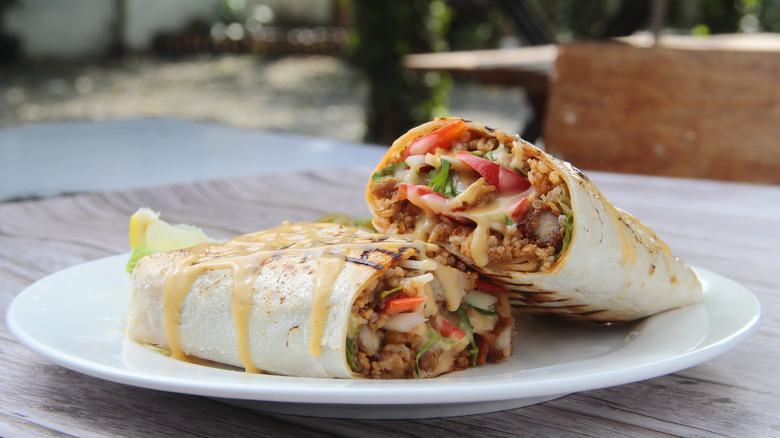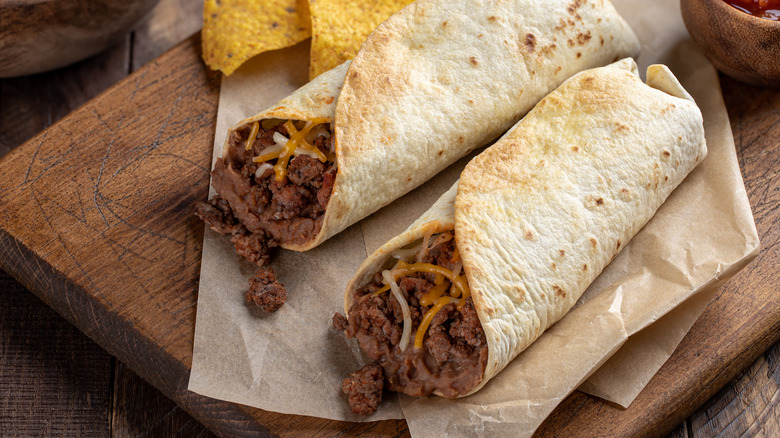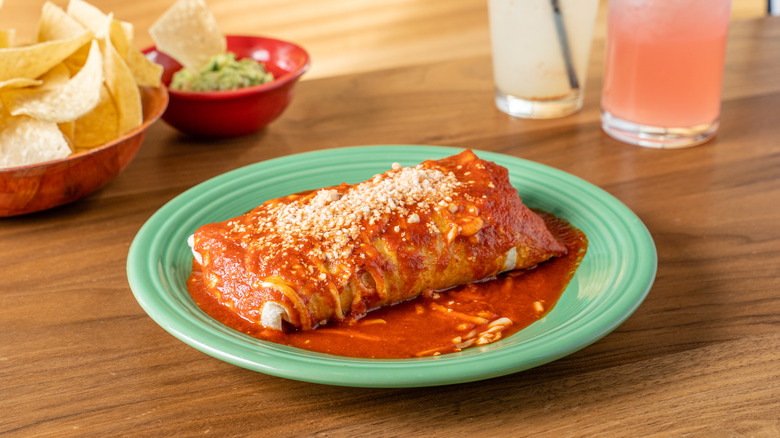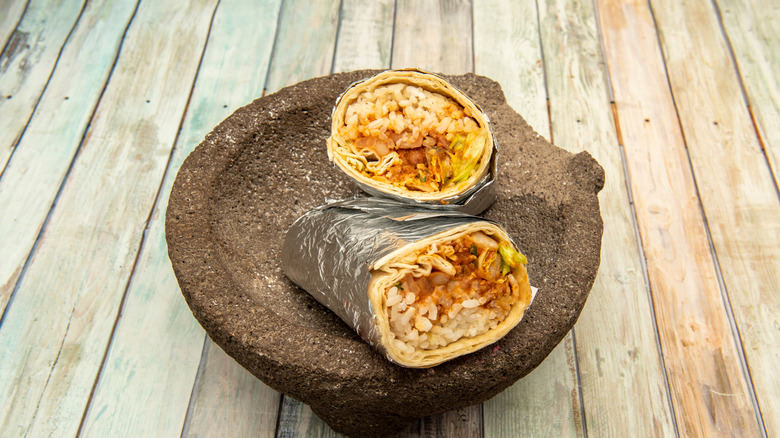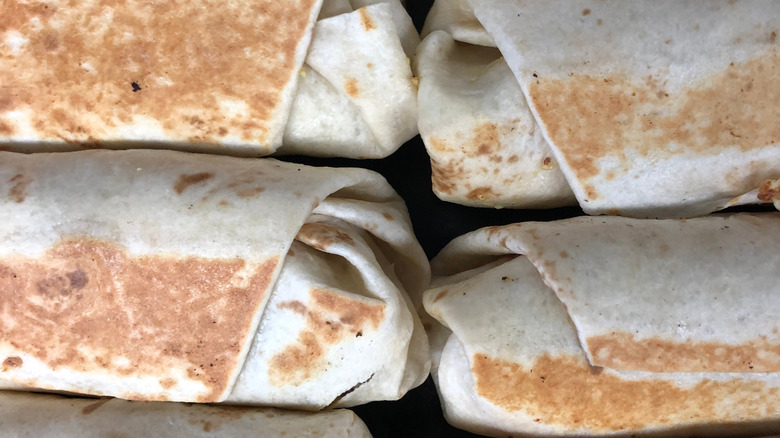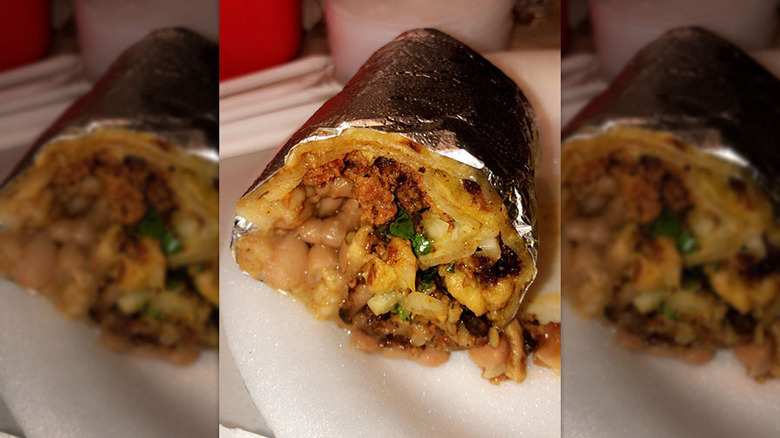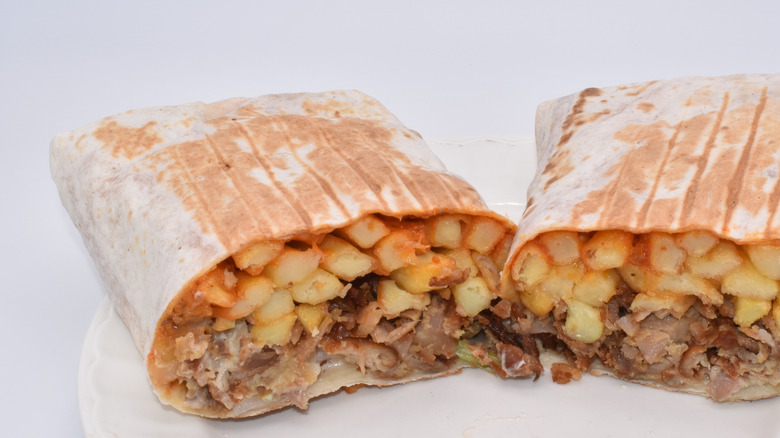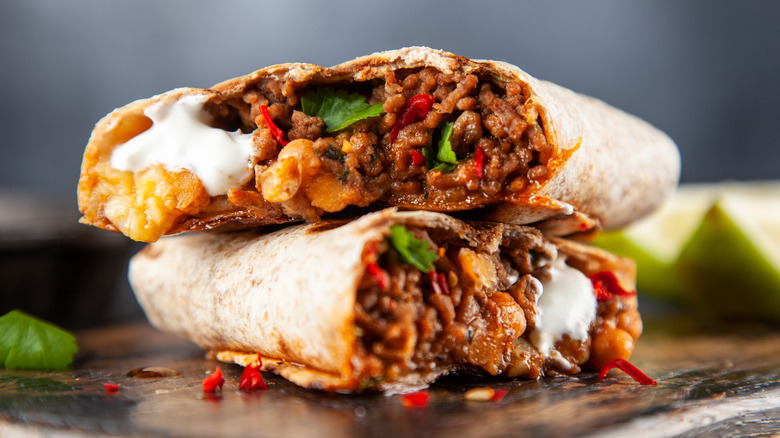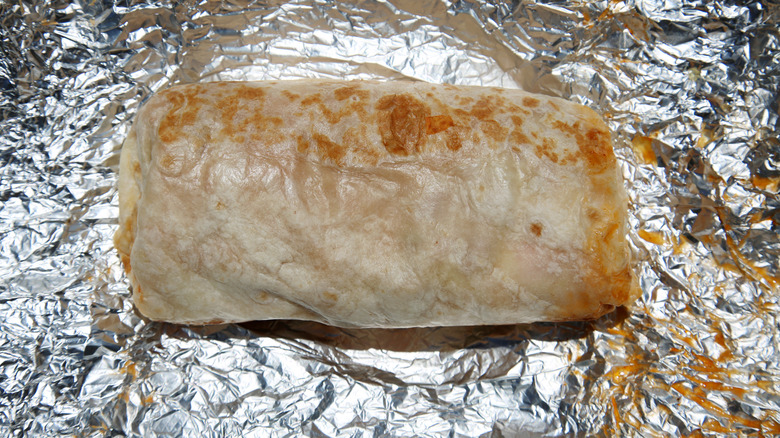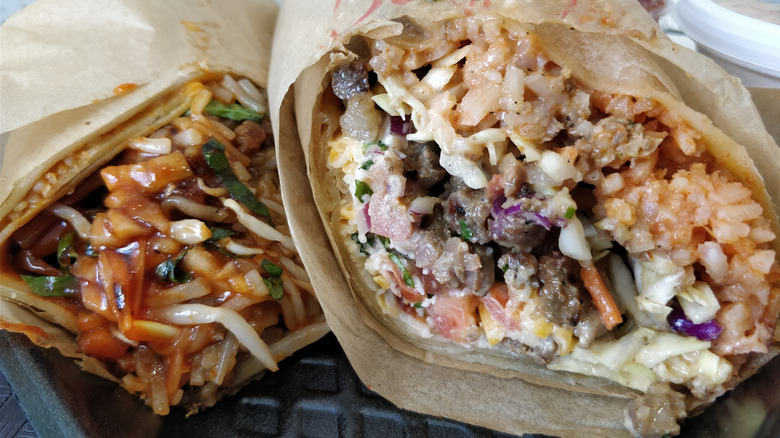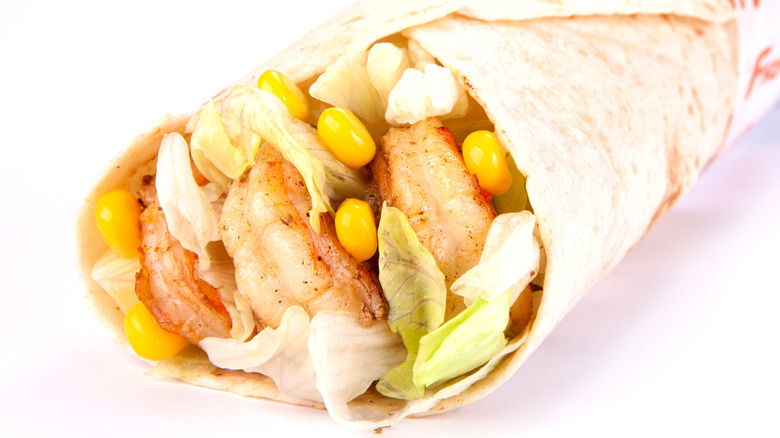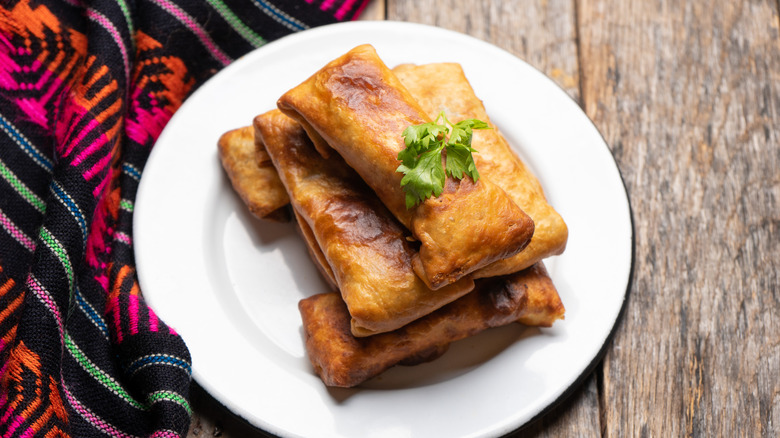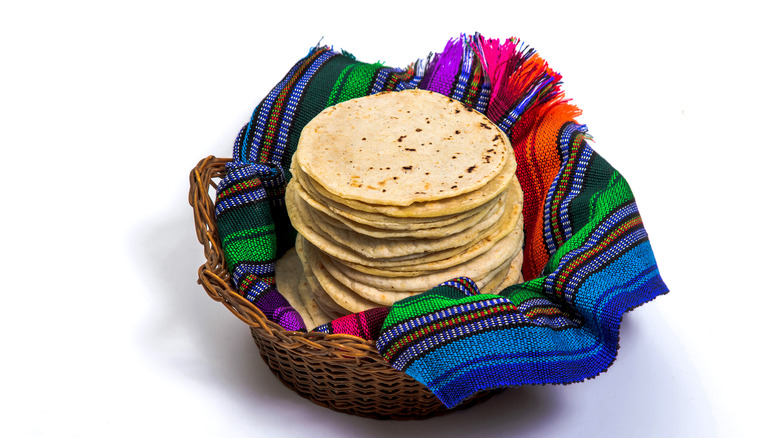12 Unique Burrito Styles You Never Knew Existed
Is there any food more perfect than a burrito? A meal that comes in its own edible container, this Mexican marvel is a fave when hunger hits — or, for that matter, when a hangover does. But burritos are not a monolith. Indeed, there are many different styles of burritos out there, including some that even burrito stalwarts may not yet have discovered.
Burritos, after all, can be filled with all manner of fillings, from meat to chicken to seafood, cheese to beans to rice. They can be wrapped in small or large tortillas made of flour or corn; they can be served as-is or sauced or griddled or even deep-fried. To get to the bottom of these defining and distinguishing features, it's time for a deep dive: This encyclopedic look at different burrito styles won't just open your eyes to the sheer range of possibilities ... it may also guide you to a new all-time favorite burrito.
1. Juarez burrito
Let's begin at the beginning, with the burrito that started it all. After all, most sources agree that burritos were first invented in Juárez. According to legend (or at least KTVU), it was here that the first burritos were made and sold, during the Mexican Revolution, in the second decade of the 20th century. These stories claim that the seller, a man named Juan Méndez, used large flour tortillas to keep his food warm, and the burrito — named for the small donkey he used to transport his street tacos throughout the Bella Vista neighborhood — was born.
According to the Netflix documentary "The Taco Chronicles," the burrito remains typical Borderland food today. In Juárez, it's first and foremost a taco in a flour tortilla, according to Fooditor. These burritos filled simply with guisado (stew) and refried beans are much smaller and less overstuffed than the burritos we're used to in the U.S.
2. Wet burrito
Dubbing a burrito "wet" might sound like an insult, but this is actually a specialty mashup of two Mexican faves: burritos and enchiladas. To make a wet burrito, a standard burrito is topped with red sauce — usually enchilada sauce — and melted cheese. For this reason, it can also be called an enchilada-style burrito or even a burrito suizo, also known as a "Swiss-style" burrito (a reference to the melted cheese topping).
Much like a classic burrito, a wet burrito can be filled with whatever you like, from beef to chicken to beans and rice. It can also be topped with avocado, sour cream, guacamole, or salsa. Unsurprisingly, and unlike many other members of the category, this burrito must be served on a plate and eaten with a knife and fork; wrapping it in foil and attempting to take it on the go is a surefire recipe for disaster.
3. Mission burrito
The massive, oversized burritos many of us associate with the category got their start in San Francisco, specifically in the neighborhood known as the Mission. Named for the 18th-century Mission Dolores, the Mission is known for its Latinx population and phenomenal taquerias.
The Mission burrito's invention is attributed to El Faro, where, in 1961, the first supersized burrito supplanted the simple Mexican wrap. Mission burritos are packed to the brim with salsa, corn, meat, guacamole, and, importantly, rice. The double load of carbs makes this style of burrito an even heftier meal than the more diminutive original from Juárez.
Today, wrapped not just in a tortilla but also in tin foil, this burrito is positively massive, perfect for when hunger strikes — and persists. It's also the burrito that most people outside of Mexico, California, and the Borderlands associate with the term, as this is the style of burrito that Chipotle has democratized, not just across the country but around the globe.
4. Dorado-style burrito
Despite what its name may have you thinking, the dorado burrito isn't named for El Dorado. In fact, unlike the mythical city of gold, a dorado burrito is fairly easy to track down.
The style started as a not-so-secret menu item at San Francisco's La Taqueria. Named after the Spanish for "golden," it is griddled on an oiled griddle until golden brown on the outside. Crispier, then, than a classic burrito, it's a local fave for good reason. (La Taqueria owner Miguel Jara tells Eater that even though it's not officially on the menu, "everybody does it.")
Griddling burritos has a number of benefits, including affording slightly more structural integrity to the otherwise floppy and flimsy tortilla and ensuring that the cheese within is melted. But it also can have a tendency to make fresh ingredients — like salsa and veg — a bit, well, damp. Proceed with caution if you've asked for a double serving of lettuce!
5. Los Angeles burrito
The division of California between North and South is no secret. Indeed, lists of their differences (most with thinly or not-at-all veiled preconceived notions) can be found all over the Internet. And these differences don't just come down to slang, vibe, or even weather — even California's burritos are divided between north and south.
Unlike in San Francisco's Mission, in Los Angeles, burritos are typically less overstuffed and left unfolded on top, according to the Bold Italic. These burritos are generally filled with refried beans (preferably refried in lard), meat, yellow cheese, and salsa. They have no lettuce, guac, or — perhaps their most essential difference — rice.
In a word, they're simpler (and perhaps a touch more manageable) than the San Francisco version. And given the lack of rice to soak up any saucy juices from the filling, they also tend to be a bit wetter than the behemoths you find in the Mission (or at Chipotle).
6. San Diego-style burrito
Even further to the south than LA, the massive San Diego-style burrito (also sometimes known as the California burrito) is distinctive thanks to the addition, not of rice, but of French fries. (No, that's no typo.)
Some San Diego locals credit Santana's with the invention of this super-stuffed burrito, but journalist Gustavo Arellano claims it hails instead from one of many local taco shops whose name ends in "berto's," all of which, Arellano claims, descend from one original Roberto's, first opened in 1964.
In addition to French fries, San Diego burritos are also known for their carne asada filling, and indeed, many San Diego taco shops will serve carne asada fries (aka a tortilla-free San Diego burrito). Usually devoid of lettuce, San Diego-style burritos often contain pico de gallo and jack cheese, and they may also feature guac or sour cream. Locals remain fiercely proud of their burritos and defend them from naysayers from the north!
7. Chile colorado burrito
A hearty, meaty, cheesy concoction made with a filling of chile-flavored beef, rice, and two kinds of cheese, the chile colorado burrito is a force to be reckoned with. And yes, that's colorado with a little c: The name of this burrito comes, not from the state, but from the Spanish word for colored, a reference to the rich, deep red chile used to make the filling. The beef, once smothered in this sauce, tinges the entire burrito a rusty hue. The resulting wrap is rich and spicy, perfect for fans of dishes with a little heat! It's also saucier and, yes, a bit messier than some other burritos on this list. But if flavor is your main deciding factor when it comes to burritos (and frankly, why shouldn't it be?) grab a roll of paper towels and a chile colorado burrito — you won't be disappointed.
8. Burro Percheron
Given that burrito is the word for a small donkey, it's perhaps no surprise that the dish known as a burro percheron is consequentially larger than most, at least in Mexico, made as it is in an enormous flour tortilla. This large, tightly wrapped burrito is typical across Sonora and Baja and is named after a particular kind of draft horse native to the Perche area of France. The restaurant Percheronisimo Burros in Hermosillo has been a specialist of the massive wrap for over 15 years, with loads of different high-quality meats and cheeses to choose from in composing your filling.
In Tuscon, Diego Armando makes a taco iteration of this typical burrito, filled with carne asada, pico, roasted green chile, avocado, and mozzarella cheese. According to Tucson.com, the cheese on this taco tends to fall off the edge and go all crispy as it cooks on the flattop grill.
9. Fusion burrito
It's no surprise that burritos are usually stuffed with Mexican-spiced fillings, from meat to beans to veg, all tinged with smoky chile heat. But some have taken the basic concept of a burrito and turned it on its head by filling it, instead, with foods hailing from far beyond Mexico's borders.
Mark Manguera and Roy Choi get the credit for developing, first the Korean taco and then the Korean burrito, filled with kalbi beef or Korean barbecued short ribs. Today, you can also find burritos filled with everything from kimchi fried rice to Filipino carnitas to Indian chicken tikka masala to Vietnamese pho. In France, meanwhile, tacos can be filled with a number of typically French foods, including cordon bleu, a breaded and fried chicken cutlet stuffed with ham and melted cheese. These days, it seems, nearly anything you can imagine can be revisited as a burrito filling!
10. Seafood burrita
A seafood burrita isn't just a burrito filled with fish or shellfish. A classic dish hailing from the coastal Mexican city of Puerto Vallarta, a burrita (which, by the way, is the feminine of burrito) is stuffed with octopus, shrimp, and fish — usually marlin — stir-fried with onions and bell peppers. The savory, flavorful hodgepodge of ingredients is rolled into a tortilla with lettuce, avocado, tomato, and cheese. Yes, cheese! Despite what many would have you believe, cheese and seafood can indeed go together; any arguments to the contrary likely surfaced with Aristotle's assessment of the effects of each ingredient on digestion, with one, fish, being quick to spoil and the other, cheese, timely to digest.
Filled with both cheese and fish, then, the resulting wrap is then griddled until golden brown.
Often, restaurants use smoked marlin in the burrita. Affectionately dubbed jamón del mar or ham of the sea, this addition imparts even more richness and a touch of smoke to the burrita.
11. Chimichanga
A chimichanga takes the excess that is a burrito and goes one step further in deep-frying it. A relative of the taquito or flauta, a chimichanga, most food historians agree, is an American invention, ostensibly created in Arizona in the 20th century — although who the instigator of the style actually was is an issue up for debate. Most legends attribute the odd name to an urban legend: Namely, that the would-be inventor accidentally dropped a burrito into the deep fryer and began to cry out a Spanish expletive beginning in chi-. Quick to censor herself, she uttered, instead, the nonsensical chimichanga, and the dish's name was born.
Much like burritos, chimichangas can be filled with pretty much anything, from meat to beans to cheese. Some opt to bake or pan-fry chimichangas to make them slightly less fatty, but a true chimichanga must be deep-fried until golden brown and crisp.
12. Corn tortilla burritos
Burritos are nearly always made with flour tortillas, and that's no surprise. Not only are flour tortillas far more pliable and flexible, making them a far more willing package for fillings, but flour is also far more common in the Borderlands, from whence the great burrito comes. (In other words, while some would have you believe that corn is "more traditional," this is far from true when it comes to burritos specifically.)
But corn burritos do exist, albeit in a much smaller form than flour. After all, their tendency to break makes it tough to roll even the more diminutive Juárez style of burrito in the maize-based wraps. Native to Southern California's Ventura, corn tortilla burritos are quite distinct in appearance from their flour-based friends. Shaped like taquitos and often deep-fried, these burritos are usually filled simply with refried beans and topped with grated cheese and spicy sauce. They're a delicious alternative to the gargantuan burritos more commonly found in California!
